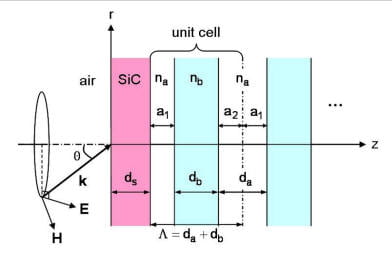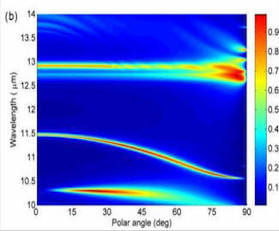Thermal radiation emitted from solids is generally manifested by a broad spectrum and quasi-isotropic angular behavior. Coherent thermal emission has drawn much attention lately for applications in thermophotovoltaic devices, optoelectronics, and space thermal management. Coherent thermal sources have been constructed using surface relief gratings by excitation of surface polaritons, which are localized electromagnetic waves that propagate along with the interface and decay into each medium. However, the grating structure can support surface polaritons only for p polarization, where the emission direction is perpendicular to the grooves.
A large number of recent studies utilize the unique features of modulated microstructures (i.e., photonic crystals) to control and improve the optical and radiative properties for specific applications. A photonic crystal (PC) is a periodic array of unit cells, or photonic lattices by analogy with those in real crystals, that replicate infinitely into one, two, or three dimensions. A salient feature of PCs is the existence of photonic band structures. In a passband, electromagnetic waves can propagate freely; whereas, in a stopband or forbidden band, no energy-carrier waves can exist inside a PC. It has been shown that a PC can support surface modes or surface waves for both polarizations in the stopband.
We proposed a potential coherent thermal emission source based on a multilayer structure made of a polar material and a one-dimensional (1-D) PC in the half-plane, as shown in Fig. 1 [1]. The unit cell of a 1-D PC is a binary layer consisting of a dielectric (type a) on both sides of a dielectric (type b) with a total thickness (lattice constant) L = da + db, where da = a1 + a2. SiC is chosen as the polar material to have coherent emission in the mid-infrared region. The unit cell of the PC The surface termination is determined by the thickness of the dielectric (a1) located at the surface of the PC.

Figure 1. Schematic of the multilayer structure made of a SiC layer coated on a semi-infinite 1-D PC.
By examining the conditions that cause a large emission in a narrow spectral range either into a well-defined direction or towards the whole hemisphere isotropically, a regime map (refer to Fig. 2a) is developed to distinguish the emissivity enhancement due to three different mechanisms: (i) the excitation of surface waves, (ii) cavity resonance mode, and (iii) the Brewster mode [2]. Here, na=2.4 nb=1.5, and L=3.0 mm (da=db). Figure 2b depicts the contour plot of the emissivity as a function of the wavelength and emission angle for p polarization. The thickness of SiC is set to be 1.45 mm. For p polarization, as an example, large values of the emissivity are found in Regions I and II, which are due to the excitation of the surface waves and cavity resonance mode, respectively. Besides Regions, I and II, enhancement of emission is also found in the wavelengths less than 10.4 mm for a wide range of the emission angles, marked as Region III. The emissivity enhancement in Region III is recognized as the Brewster mode because it occurs only for p polarization. On the other hand, the excitation of surface waves and cavity resonance mode can occur for both p and s polarizations.


Figure 2. Identification of the important regimes where the radiative properties are dominated by different mechanisms. (a) The regime map in l-q space. (b) Contour plot of the spectral-directional emissivity of the SiC-PC structure for p polarization.
The proposed planar structure involves only dielectric films, which can be fabricated with available vacuum deposition techniques. Future research is needed to measure the spectral-directional emissivity from the proposed SiC-PC structure. Physical or chemical vapor deposition techniques will be used to grown periodic layers on a suitable substrate, such as ZnSe or MgO. The refractive index of ZnSe or ZnS is near 2.4 and that of KBr or MgO is near 1.5. In order to explore coherent emission at a shorter wavelength, other polar materials, such as boron carbide (BC), boron nitride (BN), and fused silica (SiO2), can be used in place of SiC. The effect of surface wave and localization can be further studied by using metallic films, such as tungsten (W), tantalum (Ta), and vanadium (V). Furthermore, Au or Ag films can be used to tune the spontaneous emission in the visible region. Additional PC layers can be formed in front of the SiC and other absorbing films to tune the emission characteristics. The theoretical aspect of this research will focus on the understanding of surface waves, plasmon and phonon polaritons, cavity resonance, and photon localization on the optical and radiative properties of nanostructured materials. This research will have a strong impact on the development of thermophotovoltaic devices.
Publications
[1] Lee, B.J., Fu, C.J., and Zhang, Z.M., 2005, “Coherent Thermal Emission from One-dimensional Photonic Crystals,” Applied Physics Letters, 87, 071904-1/3. [selected for the August 22, 2005 issue of Virtual Journal of Nanoscale Science & Technology]
[2] Lee, B.J., and Zhang, Z.M., 2005, “Coherent Thermal Emission from Modified Periodic Multilayer Structures,” to be presented at the International Mechanical Engineering Congress and Exposition, November 5-11, 2005, Orlando, FL.